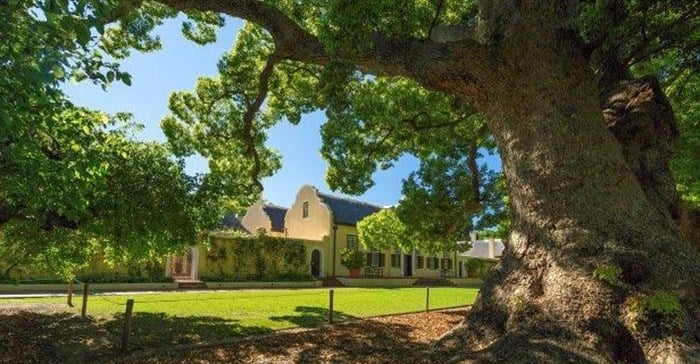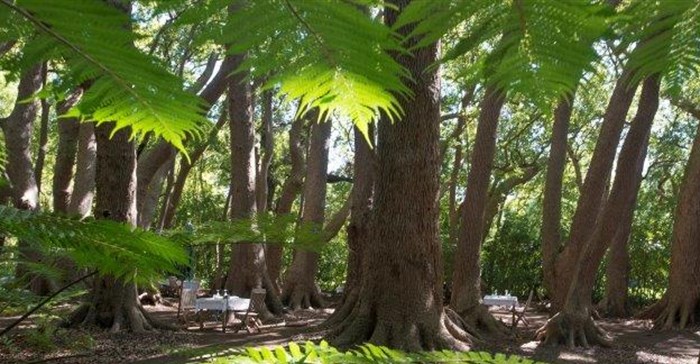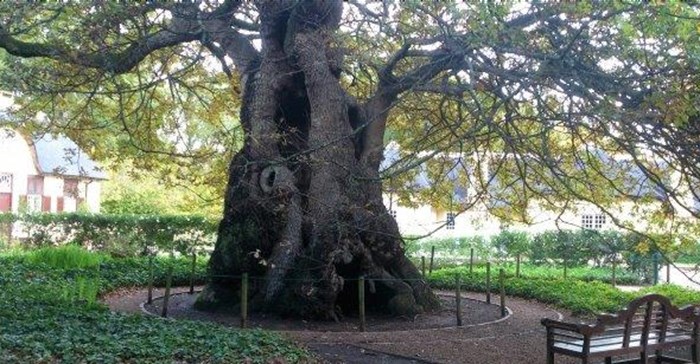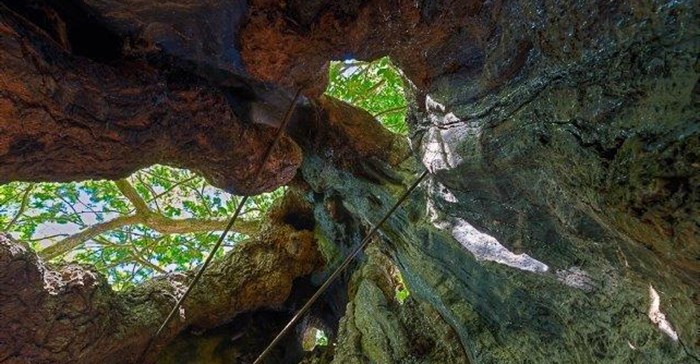Acquired by Anglo American in 1987, the estate is open to the public. Together with Groot Constantia in Cape Town, it is part of a serial nomination to become a world heritage site. “Based on international best practice, our goal is to preserve and restore the farm’s heritage, culture, viticulture and natural environment as a showcase of the very best that South Africa offers,” said Vergelegen MD Don Tooth. “Our arboreal treasures form part of this holistic approach.”
The big five
The famous “big five” at Vergelegen are five enormous camphor trees (Cinnamomum Camphora) in front of the gracious homestead. Planted by former Cape governor and Vergelegen owner Willem Adriaan van der Stel between 1700 and 1706, they were proclaimed national monuments in 1942 and should live for another 150-200 years.

Vergelegen homestead with camphor tree in foreground
Seedlings from these five gigantic specimens have been planted to form a shady camphor forest near the homestead, where guests enjoy the estate’s famous picnics in summer.

Camphor tree forest
Vergelegen is also the home of an Outeniqua yellowwood, estimated to be 150-400 years old. A hollow old English oak, about 300 years old, is believed to be the oldest living oak in Africa. The estate boasts a total of about 15 oak varieties, and launched an oak arboretum in 2012, at an event attended by members of the International Oak Society.

Vergelegen - ancient oak tree
“Our intention is to increase awareness of the history of oaks in the Cape, as well as promoting the conservation and propagation of these trees. The oak arboretum will be important for the worldwide conservation of pure species as our frost-free climate suits their propagation,” said Tooth.
Visitors are also intrigued by the story of Vergelegen’s royal oak, which was planted when the estate was owned by Sir Lionel and Lady Florence Phillips, friends of the Duchess of Marlborough. The duchess gave Sir Lionel an acorn that was one of the last from King Alfred's mediaeval oaks at Blenheim Palace in Oxfordshire.This acorn survived the sea trip from the UK to the Cape in the 1920s and duly grew into a giant oak. When King George VI and his family paid an informal visit to Vergelegen in 1947, they were delighted to hear the story about the tree with royal connections. They took some acorns back to England and had them planted in Windsor Great Park.

Vergelegen - section of ancient oak tree
The oak was again an object of royal interest when Queen Elizabeth II (who had visited Vergelegen with her parents in 1947) lunched at Vergelegen in 1995 and unveiled a plaque at the site of the famous oak tree.
Delegates of the International Garden Conference Centre, who spent an afternoon at Vergelegen in 1996, took some acorns back to England for replanting at Blenheim Palace, where they were scheduled to hold their 1998 conference. Prince Charles and the Duchess of Cornwall viewed the Vergelegen royal oak in November 2011.
Vergelegen also boasts an ancient specimen of white mulberry (Morus Alba) that is the only surviving relic of van der Stel’s attempt to start a silk industry at the Cape. This white mulberry has renewed itself over and over again as the old trunk has grown and produced branches that flop over and take root. Despite judicious trimming to keep the rampant mulberry in check, it now spreads over an area about 20 metres in diameter.
The estate also has numerous camellia trees that comprise South Africa’s first and only International Camellia Garden of Excellence – one of only 39 such gardens in the world, and the only one in Africa. The camellia gardens at Vergelegen include approximately 550 cultivars, many of them decades old.

Camellia with camphor tree and homestead in background
Tree health management
To ensure that Vergelegen’s magnificent trees remain in top condition, one of South Africa’s premier tree health management specialists, Dr Jolanda Roux (Professor at the Forestry and Agricultural Biotechnology Institute at the University of Pretoria) makes an annual visit to check on these venerable specimens. Professor Roux is a mycologist – specialising in the fungi that cause diseases in plants – and has photographic records going back over a decade.
Open to public
To view the trees at Vergelegen:
Opening hours Monday-Sunday 9.30am - 5pm (last entry 4pm).
Entrance R10/adults and R5/pensioners and scholars. Pensioners free on Mondays.
Daily heritage and garden tours (one hour) depart from the wine tasting centre daily at 10am, at R20/person.
Garden clubs can also organise tours by arrangement.















































